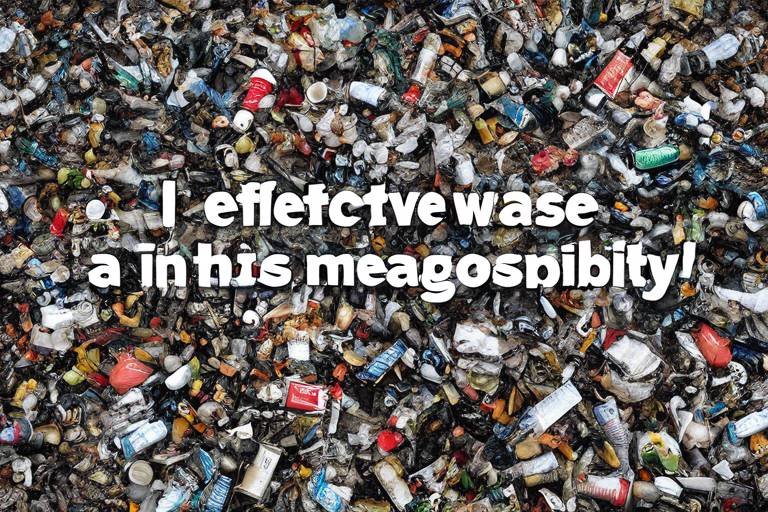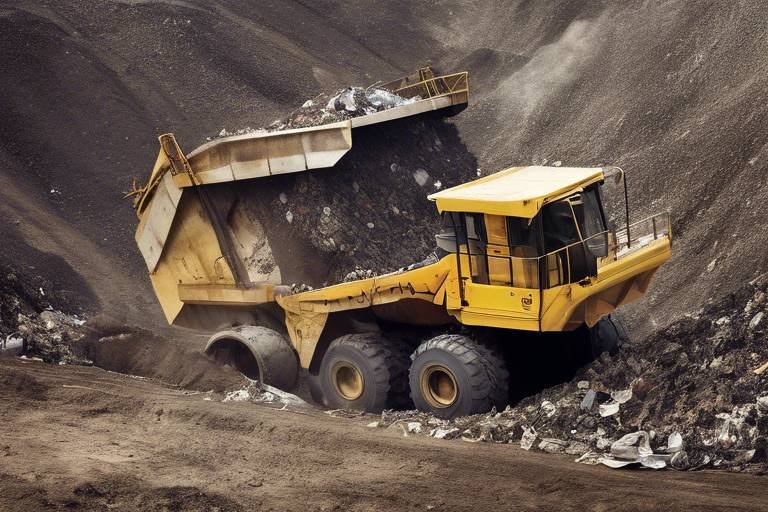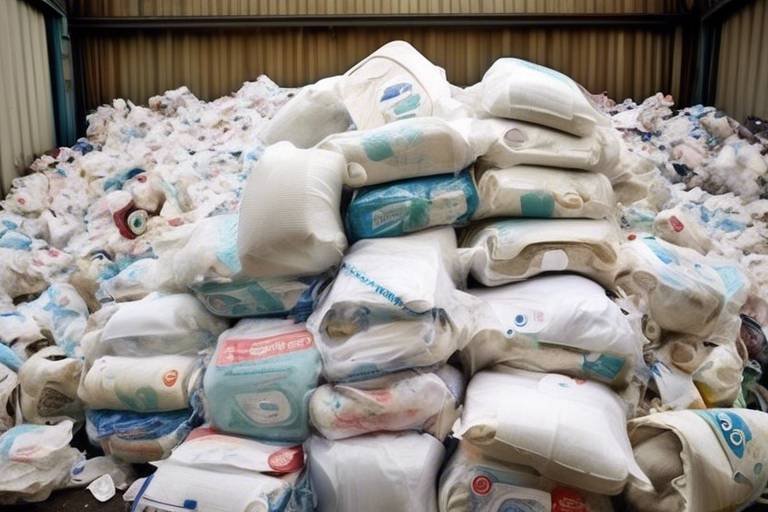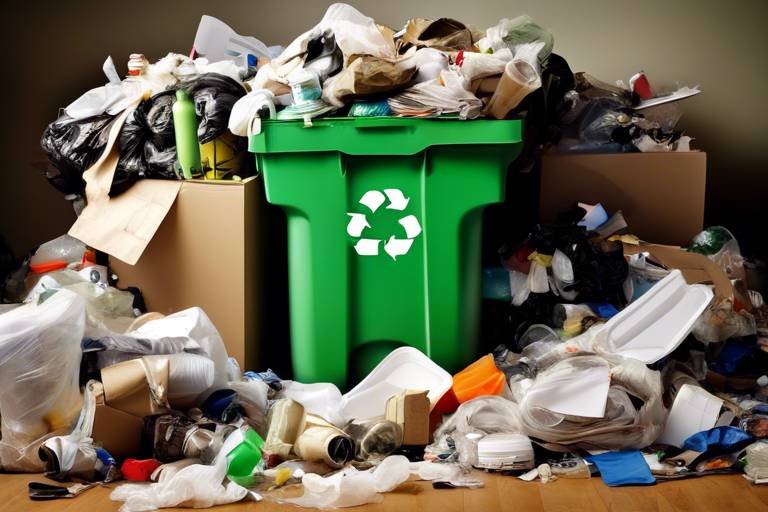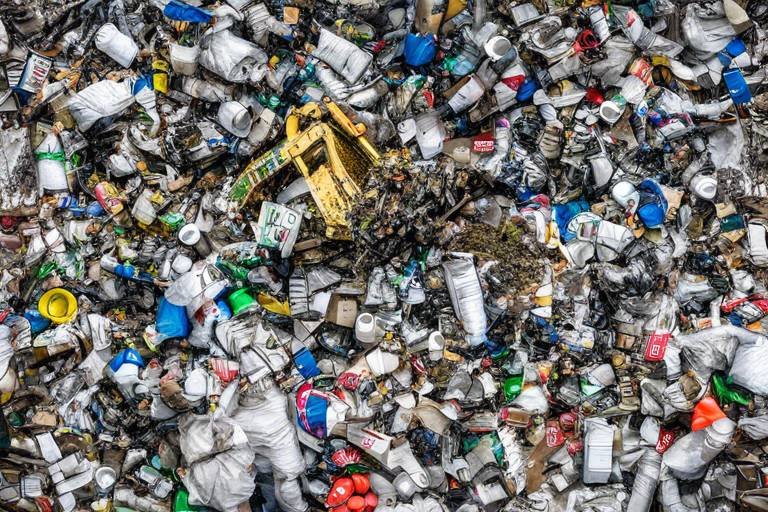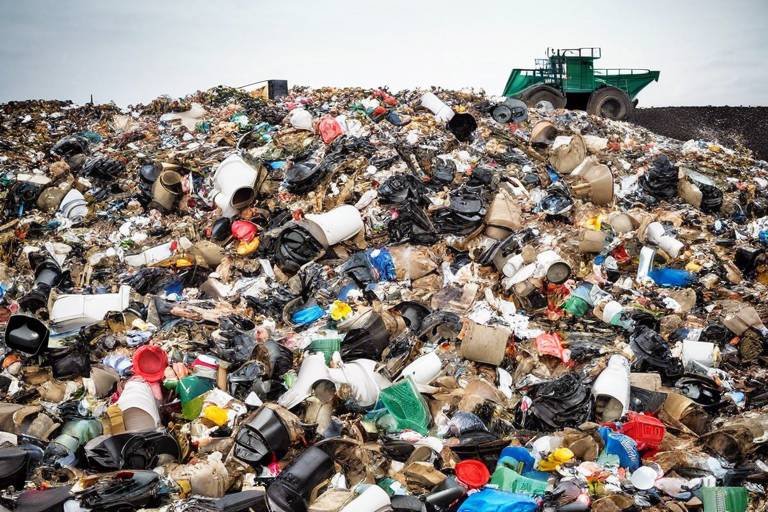Effective Waste Management - A Collective Responsibility
Waste management is not just a task for local governments or waste management companies; it is a collective responsibility that each one of us shares. As we navigate through the 21st century, the pressing need for effective waste management has never been more critical. With the world population soaring and urban areas expanding, the amount of waste generated is reaching alarming levels. This reality poses significant challenges to our environment, health, and overall quality of life.
Imagine living in a world where waste is not just discarded but transformed into valuable resources. Effective waste management practices can make this a reality. By adopting sustainable practices, we can minimize pollution, conserve natural resources, and promote public health. It’s not just about throwing trash in the right bin; it’s about understanding the lifecycle of our waste and taking actionable steps to reduce it.
Moreover, the impact of improper waste management extends beyond the immediate surroundings. Landfills release harmful gases into the atmosphere, while plastic waste clogs our oceans and endangers marine life. The consequences of inaction are dire, and the time for change is now. We must come together as a community, embracing our roles in this crucial endeavor. This means not only being responsible for our waste but also educating ourselves and others about the importance of sustainable practices.
To fully grasp the importance of waste management, we need to understand the different types of waste we generate. Waste can be broadly categorized into several types, including organic, recyclable, hazardous, and electronic waste. Each category presents unique challenges and requires specific management strategies. For instance, organic waste can be composted, turning food scraps into nutrient-rich soil, while hazardous waste demands careful handling to prevent environmental contamination.
As we delve deeper into the specifics of waste management, we will explore various strategies and techniques that can be employed at both individual and community levels. From composting and recycling to leveraging technology for smarter waste management solutions, there are countless ways we can contribute to a cleaner, more sustainable future. So, let’s embark on this journey together, taking the necessary steps to ensure that waste management becomes a shared priority among us all.
- What is waste management?
Waste management refers to the collection, transport, processing, recycling, or disposal of waste materials. It aims to reduce the negative impact of waste on the environment and human health.
- Why is waste management important?
Effective waste management is crucial for minimizing pollution, conserving resources, and promoting public health. It helps maintain a clean environment and reduces the strain on landfills.
- What are the types of waste?
Waste can be categorized into organic, recyclable, hazardous, and electronic waste, each requiring different management strategies.
- How can individuals contribute to waste management?
Individuals can contribute by practicing recycling, composting organic waste, reducing single-use plastics, and participating in community clean-up initiatives.
- What role does technology play in waste management?
Technology enhances waste management through smart bins, waste tracking systems, and data analysis, leading to more efficient collection and recycling processes.

The Importance of Waste Management
Understanding the significance of waste management is crucial for achieving environmental sustainability. It’s not just a buzzword; it’s a vital practice that affects our planet's health and our quality of life. Think about it: every time you throw something away, that item has a journey of its own. If we don’t manage that journey properly, we risk creating pollution, wasting precious resources, and endangering public health. Waste management is like the unsung hero of environmental protection, quietly working behind the scenes to keep our communities clean and safe.
One of the most pressing issues we face today is the overwhelming amount of waste generated by our fast-paced lifestyles. From plastic bottles to food scraps, the waste we produce can have devastating effects on our environment. Without effective management, this waste ends up in landfills, where it can take years, if not centuries, to decompose. In fact, did you know that approximately 30% of the waste generated globally is organic waste? This is where proper waste management comes into play, helping us reduce pollution and conserve resources.
Moreover, waste management is not just about disposal; it’s about resource conservation. By recycling and composting, we can significantly reduce the amount of waste that ends up in landfills. For instance, recycling one ton of paper can save 17 trees, 7,000 gallons of water, and enough energy to power an average home for six months. This kind of impact is not only beneficial for the environment but also for our economy, as it creates jobs and fosters innovation.
Additionally, effective waste management promotes public health. Poor waste disposal practices can lead to unsightly litter, which can attract pests and pose health risks. Communities that prioritize waste management often see a decrease in disease transmission and an overall improvement in public health standards. Imagine walking through a neighborhood that is clean and well-maintained; it not only feels good but also encourages residents to take pride in their community.
To sum it up, the importance of waste management cannot be overstated. It is a collective responsibility that requires everyone’s participation. By understanding and implementing effective waste management practices, we can create a cleaner, healthier future for ourselves and generations to come. So, what can you do to contribute? Start by being mindful of your waste habits, educate yourself and others, and participate in local recycling and composting programs. Every little bit helps!
Here’s a quick overview of the benefits of effective waste management:
| Benefit | Description |
|---|---|
| Pollution Reduction | Minimizes harmful emissions and waste in landfills. |
| Resource Conservation | Recycling and composting save energy and raw materials. |
| Public Health | Reduces disease risk and improves community well-being. |
| Economic Growth | Creates jobs and fosters innovation in waste management technologies. |
In conclusion, waste management is not just an individual task; it’s a collective responsibility. By working together and implementing sustainable practices, we can ensure a cleaner, greener future for all.
- What is waste management? Waste management refers to the collection, transport, processing, recycling, and disposal of waste materials.
- Why is waste management important? It helps reduce pollution, conserves resources, and promotes public health.
- What are the different types of waste? The main types include organic, recyclable, hazardous, and electronic waste.
- How can I contribute to waste management? You can recycle, compost, and participate in community clean-up events.

Types of Waste
When we think about waste, it’s easy to picture a messy landfill overflowing with garbage. But in reality, waste is much more diverse and can be categorized into several types, each requiring its own management approach. Understanding these categories is essential for effective waste management and environmental sustainability. The main types of waste include organic waste, recyclable waste, hazardous waste, and electronic waste.
Organic waste refers to biodegradable materials that come from living organisms. This includes food scraps, yard waste, and other natural materials. Proper management of organic waste is crucial, as it can be composted to create nutrient-rich soil, which not only reduces the volume of waste sent to landfills but also enhances soil health. On the other hand, recyclable waste comprises materials such as paper, glass, metals, and certain plastics that can be reprocessed into new products. Recycling conserves resources and reduces pollution, making it a vital aspect of waste management.
Then we have hazardous waste, which is particularly concerning due to its potential risks to human health and the environment. This type of waste includes items like batteries, chemicals, and certain medical waste that require special handling and disposal methods to prevent contamination. Lastly, electronic waste, or e-waste, consists of discarded electronic devices such as computers, televisions, and smartphones. E-waste is growing rapidly and poses unique challenges due to the toxic substances it can contain.
To summarize, here’s a quick overview of the types of waste:
| Type of Waste | Description | Examples |
|---|---|---|
| Organic Waste | Biodegradable materials from living organisms. | Food scraps, yard waste |
| Recyclable Waste | Materials that can be reprocessed into new products. | Paper, glass, metals, plastics |
| Hazardous Waste | Waste that poses risks to health and the environment. | Batteries, chemicals, medical waste |
| Electronic Waste | Discarded electronic devices. | Computers, televisions, smartphones |
By recognizing the different types of waste, we can take appropriate actions to manage them effectively. This not only helps in reducing the impact on our environment but also promotes sustainability and resource conservation. So, the next time you throw something away, take a moment to consider what type of waste it is and how it can be managed more responsibly.

Organic Waste Management
Organic waste management is a vital aspect of sustainable living that focuses on the disposal and recycling of biodegradable materials. This type of waste includes food scraps, yard trimmings, and other organic materials that can decompose naturally. The significance of managing organic waste cannot be overstated; it not only helps in reducing the volume of waste sent to landfills but also plays a crucial role in enhancing soil health through composting. Imagine your kitchen scraps transforming into rich, fertile soil instead of contributing to the ever-growing mountains of trash. It’s like giving back to the Earth while simultaneously reducing pollution!
One of the most effective ways to manage organic waste is through composting. Composting is a natural process that converts organic matter into a valuable resource known as compost. This process can be carried out in various ways, each offering unique benefits. For instance, hot composting involves maintaining high temperatures to accelerate decomposition, while cold composting is a slower process that requires minimal effort. Additionally, vermicomposting uses worms to break down organic material, resulting in nutrient-rich compost. Each method has its advantages, and choosing the right one depends on your specific needs and resources.
Moreover, community composting initiatives have gained momentum in recent years. These programs encourage local participation in waste reduction efforts, fostering a sense of community and shared responsibility. By working together, residents can learn about sustainable practices and the benefits of composting. These initiatives often include workshops and community events, making composting accessible and engaging for everyone involved. Think of it as a neighborhood potluck, but instead of sharing food, you’re sharing knowledge and resources for a cleaner environment!
To give you an idea of how impactful organic waste management can be, consider the following table that illustrates the benefits of composting:
| Benefit | Description |
|---|---|
| Reduces Landfill Waste | Composting diverts organic materials from landfills, decreasing waste volume. |
| Enhances Soil Health | Compost enriches soil with nutrients, improving plant growth and health. |
| Reduces Greenhouse Gas Emissions | Less waste in landfills means lower methane emissions, a potent greenhouse gas. |
| Promotes Biodiversity | Healthy soil supports diverse ecosystems, benefiting local flora and fauna. |
In conclusion, managing organic waste is not just about disposal; it's about creating a sustainable cycle that benefits us all. By composting and participating in community initiatives, we can significantly reduce our environmental footprint and contribute to a healthier planet. So, why not start today? Grab that kitchen scrap, and let’s turn it into something beautiful!
What is organic waste? Organic waste refers to biodegradable materials such as food scraps, yard waste, and other plant and animal matter that can decompose naturally.
Why is composting important? Composting is important because it reduces landfill waste, enriches soil, decreases greenhouse gas emissions, and promotes biodiversity.
What are the different methods of composting? The main methods of composting include hot composting, cold composting, and vermicomposting, each with its unique benefits and processes.
How can I get involved in community composting initiatives? You can get involved by participating in local workshops, joining community composting programs, or even starting your own composting group with neighbors.

Composting Techniques
Composting is a fantastic way to recycle organic waste, transforming kitchen scraps and yard debris into nutrient-rich soil that can rejuvenate gardens and landscapes. There are several techniques to consider, each with its unique benefits and requirements. Let's dive into a few of the most popular methods:
Hot Composting is a method that involves creating a compost pile that generates heat through the decomposition process. This technique is efficient and can produce compost in as little as 4 to 6 weeks. The key to hot composting is to maintain the right balance of carbon-rich materials (browns) and nitrogen-rich materials (greens). The ideal ratio is about 30:1, which means for every 30 parts of carbon, you should add 1 part of nitrogen. Regular turning of the pile will also help maintain the temperature and speed up decomposition.
On the other hand, Cold Composting is a slower process that requires less effort and is perfect for those who prefer a more hands-off approach. In this method, organic waste is simply piled up and left to decompose naturally over time. While it may take several months to a year to produce usable compost, it requires minimal maintenance and is an excellent option for those who want to compost without the hassle of frequent turning or monitoring.
Another interesting technique is Vermicomposting, which uses worms to break down organic matter. This method is particularly effective for small spaces and can be done indoors. Red wigglers are the most commonly used worms for this purpose. They consume organic waste and produce castings that are incredibly rich in nutrients, making them an ideal fertilizer for plants. Vermicomposting can be a fun and educational project for families, teaching children about the importance of recycling and sustainability.
When starting your composting journey, it's essential to consider the materials you will use. Here’s a quick overview of suitable compostable materials:
| Materials | Type |
|---|---|
| Fruit and vegetable scraps | Green |
| Grass clippings | Green |
| Dry leaves | Brown |
| Cardboard | Brown |
| Coffee grounds | Green |
| Eggshells | Brown |
In conclusion, choosing the right composting technique depends on your lifestyle, space, and how quickly you want results. Whether you opt for the speedy hot composting method, the low-maintenance cold composting, or the engaging vermicomposting, each technique contributes to reducing landfill waste and enriching the soil. By composting, you're not just managing waste; you're nurturing the earth and supporting a sustainable future.
Q1: How long does it take to make compost?
A: The time it takes to make compost can vary significantly based on the method used. Hot composting can yield finished compost in as little as 4 to 6 weeks, while cold composting may take several months to a year.
Q2: What should I avoid putting in my compost pile?
A: It's best to avoid adding meat, dairy, oils, and diseased plants to your compost pile, as these can attract pests and create odors.
Q3: Can I compost in winter?
A: Yes, you can compost in winter! While the decomposition process slows down in colder temperatures, composting can still occur. Insulating your compost pile can help maintain heat and speed up the process.
Q4: Do I need to turn my compost?
A: Turning your compost pile helps aerate it and speeds up the decomposition process. For hot composting, turning is essential, while cold composting requires little to no turning.

Community Composting Initiatives
Community composting initiatives are a powerful way to engage local residents in the fight against waste. Imagine a neighborhood where everyone comes together, not just to dispose of their organic waste, but to transform it into something beneficial for the community. These initiatives are not just about reducing waste; they are about fostering a sense of community and environmental stewardship. By participating in composting programs, residents can contribute to a sustainable cycle that enriches the soil and supports local gardens and parks.
One of the most exciting aspects of community composting is the collaboration it encourages. Local governments, non-profits, and residents can work hand in hand to create composting sites that are easily accessible. These sites often serve as educational hubs, where individuals can learn about the benefits of composting, the types of materials that can be composted, and the overall impact of waste reduction on the environment. For instance, workshops can be organized to teach residents how to separate their waste effectively and understand the composting process.
Furthermore, community composting initiatives can be tailored to meet the specific needs of each locality. Some neighborhoods might focus on composting food scraps, while others might incorporate yard waste. The beauty of these initiatives lies in their flexibility. Residents can also participate in communal compost bins, where everyone contributes their organic waste, and in return, they receive nutrient-rich compost for their gardens. This not only reduces landfill waste but also creates a sense of ownership and pride among community members.
To illustrate the impact of community composting, consider the following table that highlights the benefits:
| Benefit | Description |
|---|---|
| Waste Reduction | Reduces the amount of organic waste sent to landfills, minimizing methane emissions. |
| Soil Enrichment | Produces high-quality compost that enhances soil health and fertility. |
| Community Engagement | Encourages residents to work together towards a common goal, fostering community spirit. |
| Education | Provides learning opportunities about sustainability and environmental responsibility. |
Ultimately, community composting initiatives are about more than just compost; they are about creating a culture of sustainability and responsibility. By participating in these programs, individuals can feel empowered to make a difference in their environment. They learn that their actions—no matter how small—can contribute to a larger movement towards a cleaner, greener future. As communities come together to compost, they not only reduce waste but also strengthen their bonds, proving that collective action can lead to significant environmental change.
Q: What materials can be composted in community composting initiatives?
A: Typically, organic materials such as fruit and vegetable scraps, coffee grounds, eggshells, grass clippings, and leaves can be composted. It's important to avoid meat, dairy, and oils, as these can attract pests.
Q: How can I get involved in a community composting program?
A: You can start by checking with your local government or environmental organizations to find out if there are existing community composting programs. Many places offer workshops or volunteer opportunities.
Q: What happens to the compost produced?
A: The compost generated from community initiatives is often used in local gardens, parks, and green spaces, enriching the soil and promoting healthy plant growth.
Q: Is composting difficult to do?
A: Not at all! Community composting programs typically provide guidance and resources to help participants learn the process, making it accessible for everyone.

Recycling Practices
Recycling is not just a buzzword; it’s a crucial practice that can significantly impact our planet's health. By recycling, we conserve natural resources, reduce pollution, and minimize the amount of waste that ends up in landfills. Imagine if every person made a conscious effort to recycle; the cumulative effect would be nothing short of revolutionary! But how do we ensure that our recycling efforts are effective and efficient? Understanding proper recycling practices is key.
First and foremost, it's essential to know what can and cannot be recycled. Many people are surprised to learn that not all plastics are recyclable. For instance, items like plastic bags and food-contaminated containers often end up in the trash instead of the recycling bin. To help clarify, here’s a simple breakdown of recyclable materials:
| Material Type | Recyclable? | Notes |
|---|---|---|
| Paper | Yes | Clean paper products like newspapers and office paper. |
| Cardboard | Yes | Flattened boxes without food residue. |
| Plastics | Varies | Check for recycling symbols; #1 and #2 are commonly accepted. |
| Glass | Yes | Clear, green, and brown glass bottles and jars. |
| Metals | Yes | Aluminum cans and steel food cans. |
Once you know what can be recycled, the next step is to ensure that you’re recycling correctly. This means rinsing out containers to remove any food residue and sorting materials according to your local recycling guidelines. Did you know that contamination can ruin an entire batch of recyclable materials? That's right! A single greasy pizza box can spoil the recycling efforts of an entire truckload. So, it’s crucial to keep things clean and sorted.
Additionally, engaging in community recycling programs can amplify your efforts. Many towns and cities offer curbside recycling services, but some areas have drop-off centers for specific items like electronics or hazardous waste. Participating in these programs not only helps you recycle more effectively but also fosters a sense of community. When we come together to recycle, we share knowledge and encourage one another to adopt sustainable habits.
To further enhance recycling efforts, consider participating in or organizing local recycling drives. These events can be a great way to collect materials that may not be accepted in regular curbside programs. For instance, items like batteries, old paint, and electronics often require special handling, and community drives can facilitate proper disposal while educating participants about the importance of recycling.
In conclusion, adopting effective recycling practices is a shared responsibility that can lead to significant environmental benefits. By understanding what materials can be recycled, ensuring proper disposal, and engaging with your community, you can contribute to a cleaner, greener future. Remember, every small action counts, and together, we can make a monumental impact!
- What can I recycle? Most paper, cardboard, glass, metals, and certain plastics are recyclable. Always check local guidelines.
- How should I prepare items for recycling? Rinse containers to remove food residue and sort materials based on local recycling rules.
- What happens if I put non-recyclable items in the recycling bin? Contaminated materials can spoil entire batches, leading to more waste.
- Are there items that require special recycling? Yes, items like batteries and electronics often need to be taken to designated drop-off centers.

Hazardous Waste Management
Hazardous waste management is a critical aspect of environmental protection and public health. Understanding what hazardous waste is and how to manage it properly can prevent significant risks to both humans and the ecosystem. Hazardous waste is any material that poses a threat due to its chemical nature, which can be harmful or fatal if not handled correctly. This includes items like batteries, paints, solvents, and electronic waste that contain toxic substances.
One of the first steps in effective hazardous waste management is identifying hazardous waste. It is essential to recognize common household items that fall under this category. For instance, many people are unaware that products such as old electronics, cleaning supplies, and certain types of light bulbs can be hazardous. Proper identification helps in taking the necessary precautions for safe handling and disposal.
To effectively manage hazardous waste, it is crucial to implement safe disposal methods. Communities often establish designated drop-off centers or organize specialized collection events to facilitate the safe disposal of hazardous materials. These initiatives not only ensure that harmful substances are disposed of responsibly but also promote community engagement in environmental stewardship.
Here are some safe disposal methods for hazardous waste:
- Designated Drop-Off Centers: Many local governments provide specific locations where residents can drop off hazardous waste for safe disposal.
- Specialized Collection Events: Communities may organize events where residents can bring their hazardous waste for safe and proper disposal, often at no cost.
- Manufacturer Take-Back Programs: Some manufacturers offer programs to take back their products for safe disposal or recycling, especially for electronics and batteries.
Moreover, it is essential to educate the public about the dangers associated with improper disposal of hazardous waste. When these materials are thrown away with regular trash, they can leach into the soil and water, leading to serious environmental contamination. This not only harms wildlife but can also enter the food chain, posing health risks to humans as well. Therefore, community education programs play a vital role in fostering awareness and promoting responsible waste management practices.
In conclusion, managing hazardous waste effectively requires a collective effort from individuals, communities, and local governments. By understanding what constitutes hazardous waste, utilizing safe disposal methods, and engaging in public education, we can significantly reduce the risks associated with these materials. Remember, the responsibility lies with each of us to ensure a safer and cleaner environment for future generations.
What is hazardous waste?
Hazardous waste is any waste that poses substantial or potential threats to public health or the environment. This includes materials that are flammable, corrosive, reactive, or toxic.
How can I identify hazardous waste in my home?
Look for products that have warning labels such as "flammable," "toxic," "corrosive," or "reactive." Common items include batteries, paints, pesticides, and certain cleaning products.
What should I do with hazardous waste?
Do not throw hazardous waste in the regular trash. Instead, take it to a designated drop-off center or participate in local hazardous waste collection events.
Are there any penalties for improper disposal of hazardous waste?
Yes, improper disposal of hazardous waste can lead to significant penalties, including fines and legal action, as it poses serious risks to public health and the environment.

Identifying Hazardous Waste
Identifying hazardous waste is a crucial first step in managing waste responsibly and protecting both human health and the environment. Hazardous waste is any material that can pose a significant risk to public health or the environment if not handled properly. This type of waste can be found in various forms and originates from different sources, such as households, industries, and medical facilities. Understanding what constitutes hazardous waste is essential for ensuring safe disposal and minimizing contamination risks.
Common examples of hazardous waste include:
- Batteries: These can contain heavy metals like lead and cadmium, which are toxic to both humans and wildlife.
- Chemicals: Household cleaners, pesticides, and solvents often contain harmful substances that can pollute the environment.
- Electronic Waste: Items like old computers, televisions, and smartphones contain hazardous materials such as mercury and lead.
It's important to note that hazardous waste is not limited to industrial byproducts; many everyday items can be considered hazardous. For instance, paint thinners, certain light bulbs, and even some medications can fall into this category. To help you identify hazardous waste, here’s a simple table outlining the characteristics and examples:
| Characteristics | Examples |
|---|---|
| Flammable | Gasoline, paint thinners |
| Corrosive | Acids, battery acid |
| Toxic | Pesticides, heavy metals |
| Reactive | Some cleaning products, certain batteries |
By recognizing these hazardous materials, individuals and communities can take proactive steps to ensure they are disposed of safely. Always check local regulations regarding hazardous waste; many communities offer designated drop-off locations or special collection events to facilitate responsible disposal. Remember, the goal is to protect our environment and public health, and that starts with being informed about what hazardous waste is and how to manage it effectively.
- What should I do if I have hazardous waste at home? It's best to contact your local waste management authority for guidance on safe disposal methods specific to your area.
- Can I throw hazardous waste in the regular trash? No, hazardous waste should never be thrown in the regular trash as it can contaminate landfills and pose risks to the environment and public health.
- How can I safely dispose of old batteries? Many retailers offer battery recycling programs, or you can take them to designated hazardous waste collection events.

Safe Disposal Methods
When it comes to managing hazardous waste, understanding is crucial for protecting both human health and the environment. This type of waste can include a variety of materials, such as batteries, chemicals, and electronic devices, all of which require special handling to prevent contamination and harm. One of the most effective strategies for safe disposal is utilizing designated drop-off centers. These centers are specifically designed to handle hazardous materials and ensure they are disposed of in an environmentally friendly manner.
In addition to drop-off centers, many communities organize specialized collection events where residents can safely dispose of hazardous waste. These events often occur on a scheduled basis, making it convenient for individuals to participate. For example, some local governments may hold annual or biannual collection days for items like paint, solvents, and old electronics. This not only helps keep hazardous materials out of landfills but also raises awareness about the importance of proper waste disposal.
Furthermore, it's essential to educate the community about the dangers of improper disposal. Many people might not realize that throwing hazardous waste in regular trash can lead to serious environmental issues, such as soil and water contamination. By promoting safe disposal methods, we can significantly reduce the risks associated with hazardous waste.
To summarize, here are some key safe disposal methods that everyone should be aware of:
- Designated Drop-Off Centers: Facilities specifically equipped to handle hazardous materials.
- Specialized Collection Events: Community events for safe disposal of hazardous waste.
- Public Education: Raising awareness about the dangers of improper disposal.
By adopting these methods, we can collectively take steps toward a cleaner and safer environment. Remember, your actions matter! Every small effort counts in the quest for effective waste management.
Q1: What types of materials are considered hazardous waste?
A1: Hazardous waste includes items such as batteries, chemicals, paints, pesticides, and electronic waste. These materials can pose risks to human health and the environment if not disposed of properly.
Q2: How can I find a local drop-off center for hazardous waste?
A2: You can typically find local drop-off centers through your city or county's waste management website. Many municipalities provide information on designated locations and their operating hours.
Q3: Are there any fees associated with disposing of hazardous waste?
A3: Some drop-off centers and collection events may charge a fee for certain items, while others may offer free disposal. It’s best to check in advance to understand any potential costs.
Q4: What should I do if I can't make it to a collection event?
A4: If you are unable to attend a collection event, consider storing the hazardous materials safely until the next event or until you can reach a designated drop-off center. Never dispose of these materials in regular trash.

The Role of Technology in Waste Management
In today's world, technology is not just a luxury; it's a necessity, especially when it comes to managing waste effectively. With our growing population and increasing consumption, traditional waste management methods are becoming insufficient. Imagine a world where trash is not just tossed away but is monitored, tracked, and recycled efficiently. That’s the power of technology in waste management! From smart bins that communicate when they're full to data analytics that help municipalities plan better, technology is transforming how we handle waste.
One of the most exciting developments is the introduction of smart waste management solutions. These systems use sensors and IoT (Internet of Things) technology to optimize collection routes. For example, a smart bin can notify waste collectors when it’s nearing capacity, which means no more unnecessary trips to empty bins that are only partially full. This not only saves time and fuel but also reduces greenhouse gas emissions, making waste collection more environmentally friendly. It's like having a personal assistant for your trash!
Moreover, technology enables data-driven decision making in waste management. By analyzing data on waste generation patterns, communities can identify trends and tailor their recycling programs accordingly. For instance, if a neighborhood generates a lot of organic waste, local authorities can implement specific composting initiatives. This targeted approach not only improves recycling rates but also fosters a culture of sustainability. Imagine if every community could access real-time data about their waste habits; the potential for improvement is staggering!
In addition to smart bins and data analytics, there are also innovative apps that promote recycling and waste reduction. These applications can provide users with information on how to recycle various materials, where to find recycling centers, and even tips on reducing waste at home. It’s like having an eco-friendly coach right in your pocket! Furthermore, some cities are employing AI (Artificial Intelligence) to sort waste at recycling facilities, improving the efficiency and accuracy of the recycling process.
Let’s not forget about the role of technology in raising awareness. Social media campaigns, websites, and mobile apps are powerful tools for educating the public about waste management issues. They can engage communities, share success stories, and encourage individuals to take action. For example, a community might launch a challenge through a mobile app where residents track their waste reduction efforts, fostering a sense of competition and camaraderie.
In conclusion, the integration of technology in waste management is a game changer. It not only streamlines processes but also empowers communities to take charge of their waste. By leveraging these technological advancements, we can create a cleaner, more sustainable future. The question is, are we ready to embrace this change?
- How does technology improve waste management?
Technology enhances waste management by optimizing collection routes, providing real-time data, and facilitating better recycling practices. - What are smart bins?
Smart bins are equipped with sensors that alert waste collectors when they are full, reducing unnecessary trips and improving efficiency. - Can apps help with recycling?
Yes, there are various apps designed to educate users on recycling practices, locate recycling centers, and promote waste reduction strategies. - What is data-driven decision making in waste management?
This approach involves analyzing waste generation data to tailor recycling programs and initiatives effectively.

Smart Waste Management Solutions
In today's fast-paced world, the integration of technology into waste management is not just a luxury; it's a necessity. are revolutionizing how communities handle waste, making processes more efficient and environmentally friendly. Imagine a scenario where waste collection is optimized, not just based on a schedule, but on real-time data. This is the beauty of smart technology in waste management.
One of the most exciting advancements is the use of smart bins. These bins are equipped with sensors that monitor waste levels and send alerts when they need to be emptied. This means that waste collection trucks can follow optimized routes, reducing fuel consumption and greenhouse gas emissions. Instead of making unnecessary trips to empty bins that aren’t full, these trucks can focus on areas that need immediate attention. This shift not only saves money but also helps in conserving resources.
Moreover, waste tracking systems are becoming increasingly popular. By utilizing GPS and data analytics, these systems provide valuable insights into waste generation patterns. For example, a community can analyze which areas produce the most waste and tailor recycling programs accordingly. This data-driven approach ensures that resources are allocated efficiently and that efforts are concentrated where they are most needed.
Another noteworthy aspect of smart waste management is the potential for public engagement. Many smart waste solutions come with mobile apps that allow residents to report overflowing bins or request pickups. This creates a direct line of communication between the community and waste management authorities, fostering a sense of responsibility and involvement among residents. When individuals feel empowered to take action, it leads to a more proactive approach to waste reduction.
To illustrate the impact of technology in waste management, consider the following table that compares traditional waste management practices with smart waste management solutions:
| Aspect | Traditional Waste Management | Smart Waste Management |
|---|---|---|
| Collection Schedule | Fixed schedule regardless of need | Dynamic scheduling based on real-time data |
| Operational Efficiency | Often inefficient with unnecessary trips | Optimized routes reduce fuel consumption |
| Community Engagement | Limited interaction with residents | Direct communication through apps |
| Data Utilization | Minimal data analysis | Comprehensive data-driven strategies |
As we move forward, the role of technology in waste management will only grow. Communities that embrace these smart solutions are not only improving their waste management processes but are also setting a precedent for sustainability. By leveraging technology, we can create cleaner, greener, and more efficient environments for future generations.
Q1: What are smart bins?
Smart bins are waste containers equipped with sensors that monitor waste levels and communicate when they need to be emptied, optimizing collection routes.
Q2: How can technology improve waste management?
Technology enhances waste management by providing real-time data for efficient collection, reducing costs, and encouraging community engagement through mobile applications.
Q3: Are smart waste management solutions expensive to implement?
While the initial investment may be higher, the long-term savings in operational costs and environmental benefits make smart waste management solutions a worthwhile investment.
Q4: How can I get involved in my community's waste management efforts?
You can participate by using local apps to report issues, joining community clean-up events, or advocating for smart waste solutions in your area.

Data-Driven Decision Making
In the realm of waste management, has emerged as a game changer. Imagine trying to navigate through a dense fog without a map; that's what managing waste without data feels like. By harnessing the power of data, communities can identify trends, optimize processes, and ultimately make informed decisions that lead to better waste management practices.
Data analytics allows waste management authorities to understand the nuances of waste generation patterns. For instance, by analyzing data collected from various neighborhoods, officials can pinpoint which areas produce more waste and what types of waste are most prevalent. This information is crucial when it comes to tailoring waste collection schedules and recycling programs to meet the specific needs of different communities.
Moreover, data-driven strategies can significantly enhance the efficiency of recycling programs. By examining the composition of waste, authorities can determine which materials are most commonly discarded and adjust their outreach efforts accordingly. For example, if data reveals that a significant amount of recyclable plastics is found in the waste stream, targeted campaigns can be launched to educate residents on proper recycling practices. This not only increases recycling rates but also fosters a culture of sustainability within the community.
To illustrate the impact of data-driven decision making, consider the following table that outlines key benefits:
| Benefit | Description |
|---|---|
| Enhanced Efficiency | Optimizes waste collection routes based on real-time data, reducing fuel consumption and operational costs. |
| Improved Recycling Rates | Identifies materials frequently discarded, allowing for targeted education and increased recycling participation. |
| Informed Policy Making | Data insights guide policymakers in developing regulations and initiatives that address specific waste management challenges. |
| Community Engagement | Utilizes data to create tailored outreach programs that resonate with the community, fostering greater involvement in sustainability efforts. |
As we move forward into an era where technology and data are intertwined, the importance of data-driven decision making in waste management cannot be overstated. Communities that embrace this approach are not only equipped to tackle current waste challenges effectively but are also prepared for future sustainability goals. By leveraging data, we can transform waste management from a reactive process into a proactive strategy that benefits both the environment and public health.
- What is data-driven decision making in waste management? It involves using data analytics to inform and enhance waste management strategies, leading to more effective and sustainable practices.
- How can communities collect data for waste management? Communities can utilize smart bins, surveys, and waste audits to gather data on waste generation patterns and recycling behaviors.
- What are some examples of data-driven initiatives? Examples include optimizing collection routes based on waste volume data and launching targeted recycling campaigns based on material composition analysis.
- Why is community engagement important in this process? Engaging the community ensures that waste management strategies are tailored to their needs, fostering a sense of shared responsibility and encouraging sustainable behaviors.

Community Involvement and Education
Community involvement is not just a buzzword; it’s the backbone of effective waste management. When individuals come together, the impact can be monumental. Imagine a neighborhood where everyone takes an active role in reducing waste—sounds like a dream, right? But it’s entirely possible through education and collaborative efforts. By fostering a culture of responsibility and awareness, communities can significantly enhance their waste management practices.
Education plays a pivotal role in this process. It's not enough to simply tell people to recycle or compost; they need to understand *why* these actions matter. When residents grasp the environmental and health implications of waste, they’re more likely to participate actively. For instance, schools can incorporate waste management topics into their curriculums, teaching children about the importance of sustainability from a young age. This not only equips the next generation with knowledge but also encourages families to adopt greener practices at home.
Moreover, awareness campaigns can be a game-changer. These campaigns can take many forms, such as:
- Workshops that demonstrate effective recycling and composting techniques.
- Community clean-up events that bring people together for a common cause.
- Social media campaigns that spread information quickly and widely.
Engaging with the community through these initiatives creates a sense of ownership and pride. When people see the tangible results of their efforts—like cleaner parks or reduced litter—they’re motivated to continue participating. It’s like planting a seed; with time and care, it blossoms into something beautiful.
Volunteer programs are another fantastic avenue for community involvement. These initiatives allow residents to roll up their sleeves and actively contribute to waste management efforts. Whether it’s organizing a recycling drive or participating in a local composting project, volunteers play a crucial role in fostering a sustainable environment. Not only do these programs help manage waste, but they also build camaraderie among participants, reinforcing the idea that everyone has a part to play in this collective responsibility.
In summary, community involvement and education are essential components of effective waste management. By empowering individuals with knowledge and providing opportunities for active participation, communities can create a cleaner, healthier environment for everyone. The more we work together, the more significant impact we can make. So, let’s roll up our sleeves and get involved!
| Question | Answer |
|---|---|
| How can I get involved in local waste management initiatives? | Contact your local municipality or community center to find out about volunteer opportunities and upcoming events. |
| What are some simple ways to reduce waste at home? | Start by composting food scraps, using reusable bags, and recycling properly. Small changes can lead to significant impacts! |
| Are there any resources for learning more about waste management? | Yes! Many organizations offer workshops and online resources. Check local environmental groups or educational websites for more information. |

Awareness Campaigns
Awareness campaigns are essential tools in the fight for effective waste management. They serve as a bridge between knowledge and action, helping to transform public perception about waste and its impact on our environment. Imagine a community where every individual understands the importance of reducing, reusing, and recycling. It sounds like a dream, right? But with well-structured awareness campaigns, this dream can become a reality.
These campaigns can take various forms, from engaging social media posts to community workshops and events. The goal is to create a buzz around waste management issues, encouraging everyone to participate actively. For instance, local governments and organizations often collaborate to run events that educate residents on how to properly sort their waste, the benefits of composting, and the importance of recycling. By making information accessible and engaging, these campaigns can significantly shift community behaviors.
One effective approach is to leverage storytelling. By sharing personal experiences or success stories from community members who have adopted sustainable practices, others are inspired to follow suit. For example, a local family might share their journey of reducing food waste through composting, illustrating how simple changes can lead to significant environmental benefits.
Moreover, awareness campaigns can incorporate fun and interactive elements to capture the attention of diverse audiences. Contests, challenges, and community clean-up days not only promote participation but also foster a sense of camaraderie among residents. When people come together for a common cause, they build stronger community ties and a shared commitment to environmental stewardship.
To maximize their impact, awareness campaigns should also utilize various channels to reach a broader audience. This includes:
- Social Media Platforms: Creating shareable content that resonates with the community.
- Local News Outlets: Partnering with newspapers and radio stations to spread the word.
- Schools and Educational Institutions: Implementing programs that teach students about waste management from a young age.
Ultimately, the effectiveness of awareness campaigns hinges on their ability to resonate with the community. By making waste management relatable and actionable, we can inspire individuals to take responsibility for their waste. Remember, every small action contributes to a larger movement towards sustainability.
Q: What is the main goal of awareness campaigns related to waste management?
A: The primary goal is to educate the public about the importance of waste management practices, encouraging individuals and communities to adopt sustainable habits that reduce waste and promote recycling.
Q: How can I get involved in local awareness campaigns?
A: You can participate by attending community events, volunteering for local clean-up initiatives, or even starting your own awareness campaign within your neighborhood.
Q: Are there any resources available for creating awareness campaigns?
A: Yes, many organizations provide toolkits and resources online that offer guidance on how to plan and execute effective awareness campaigns focused on waste management.

Volunteer Programs
Engaging in is one of the most impactful ways individuals can contribute to effective waste management in their communities. These programs not only provide a platform for hands-on involvement but also foster a sense of community and shared responsibility. Imagine a neighborhood coming together, united by a common goal to reduce waste and promote sustainability. It’s not just about picking up trash; it’s about creating a culture of environmental stewardship.
Volunteering in waste management initiatives can take many forms. From organizing community clean-up days to participating in educational workshops, volunteers help raise awareness about the importance of proper waste disposal and recycling practices. For instance, a local park clean-up day might involve:
- Picking up litter and debris
- Sorting recyclable materials
- Educating participants about waste reduction strategies
Furthermore, many organizations offer structured volunteer programs that include training sessions. These sessions equip volunteers with the knowledge and skills necessary to tackle waste management challenges effectively. By participating in these programs, individuals can learn about:
- The types of waste and their proper disposal methods
- How to compost organic waste
- Techniques for promoting recycling within their communities
Moreover, volunteering can lead to the development of new friendships and networks. When people come together for a cause, they often find common ground and build lasting relationships. This camaraderie can be a powerful motivator, encouraging more individuals to join in and make a difference. Plus, it’s a great way to get outside, enjoy nature, and feel a sense of accomplishment after a day of hard work.
In addition to local efforts, many volunteer programs are linked to larger organizations that focus on national or global waste management issues. For example, international campaigns like Earth Day or World Cleanup Day mobilize millions of volunteers worldwide, amplifying the impact of local actions. Participating in these global initiatives can provide volunteers with a sense of belonging to a much larger movement, reinforcing the idea that every small effort counts.
In summary, volunteer programs are essential for promoting effective waste management. They empower individuals, foster community spirit, and educate people about the importance of sustainable practices. So, why not take that first step? Join a local volunteer program and become a part of the solution. Together, we can create a cleaner, healthier environment for future generations.
1. How can I find volunteer programs in my area?
You can search online for local environmental organizations, check community bulletin boards, or visit websites dedicated to volunteer opportunities.
2. What types of activities do volunteers typically participate in?
Volunteers may engage in activities like park clean-ups, recycling drives, educational workshops, and community awareness campaigns.
3. Is prior experience required to volunteer?
No prior experience is usually needed. Most programs offer training to help you understand your role and the importance of waste management.
4. Can volunteering lead to job opportunities?
Absolutely! Volunteering can provide valuable experience, networking opportunities, and even lead to job offers in the environmental field.
5. How can I encourage others to participate in volunteer programs?
Share your experiences on social media, invite friends to join you, and promote local events to raise awareness about the importance of waste management.
Frequently Asked Questions
- What is waste management and why is it important?
Waste management refers to the collection, transportation, processing, and disposal of waste materials. It’s crucial for maintaining a clean environment, reducing pollution, conserving resources, and promoting public health. Without effective waste management, our surroundings can become hazardous, leading to negative impacts on both human health and the ecosystem.
- What are the different types of waste?
Waste can be categorized into several types, including organic waste (like food scraps), recyclable materials (such as paper and plastics), hazardous waste (like batteries and chemicals), and electronic waste (e-waste). Each type requires specific management strategies to minimize environmental impact and ensure safe disposal.
- How can I manage organic waste effectively?
Organic waste can be managed through composting, which transforms food scraps and yard waste into nutrient-rich soil. Techniques like hot composting, cold composting, and vermicomposting can be employed depending on your resources and preferences. This not only reduces landfill use but also enriches the soil, making it a win-win for the environment!
- What should I do with hazardous waste?
Hazardous waste, such as batteries and certain chemicals, requires careful handling. It’s essential to identify these materials and use designated drop-off centers or participate in specialized collection events for safe disposal. This helps prevent contamination of the environment and protects public health.
- How does technology improve waste management?
Technology enhances waste management through innovations like smart bins and waste tracking systems. These tools optimize collection routes, monitor waste levels, and analyze data to improve recycling programs. By leveraging technology, communities can reduce costs and boost efficiency in their waste management efforts.
- Why is community involvement important in waste management?
Community involvement is vital because it fosters a sense of shared responsibility toward the environment. Engaging individuals through education programs, awareness campaigns, and volunteer opportunities empowers them to adopt sustainable practices and actively participate in local waste management initiatives.
- How can I get involved in local waste management initiatives?
You can get involved by participating in local volunteer programs, attending workshops, or joining community awareness campaigns. Many municipalities have initiatives focused on waste reduction and recycling, so reaching out to your local government or environmental organizations is a great start!

